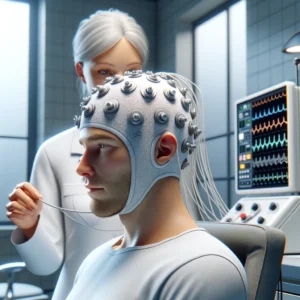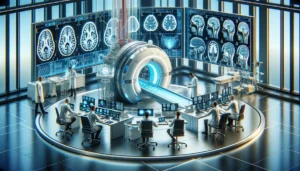Traumatic brain injury (TBI) causes progressive neurodegeneration by initiating various biochemical processes. Neurological damage occurs at the moment of TBI impact and can develop over time following an impact. Some studies have reported that in elderly patients with a history of moderate traumatic brain injury, there is a 2.3 times greater risk of developing Alzheimer’s disease than older people with no history of head injury. Patients with a history of severe traumatic brain injury have a risk of 4.5 times.
What is neurodegeneration after traumatic brain injury (TBI)?
Depending on the location and severity of TBI, it induces some neuropathological effects immediately. The increase in the severity of TBI causes neural damage and neurodegeneration. In the first phase of neurodegeneration, injury initiates primary and secondary neuropathological effects. However, even in the choric phase, these changes progressively occur. Neuronal damage from TBI causes anatomical as well as pathophysiological changes. It can lead to dementia. Traumatic brain injury increases the incidence of heterogeneous neurological and chronic neurodegenerative disorders, such as Alzheimer’s disease, Parkinson’s disease, etc.
What are the symptoms of neurodegeneration after TBI?
Symptoms of neurodegeneration following TBI are partly putative clinical features of chronic traumatic encephalopathy (CTE) and sometimes overlap with brain injury’s direct psychiatric and cognitive effects. Some diverse symptoms include memory loss, headache, aggression, difficulty finding words, cognitive dysfunction, behavioral disturbances, motor-related symptoms, etc. These symptoms are common as a direct result of TBI.
How is neurodegeneration after TBI diagnosed and treated?
Doctors can use neuroimaging quantification in the diagnosis of neurodegeneration after TBI. The neuroimaging studies show degenerative effects on the brain with time.
- MRI: MRI is a popular technique used to assess neurodegeneration following TBI as it is sensitive to hemorrhage, contusions, and features associated with axonal injuries like microhemorrhages. Brain atrophy offers a key measure of disease progression in neurodegenerative conditions. Atrophy is produced due to neuronal loss, which can be easily measured with serial MRI. Although it is a non-specific way to assess progressive neurodegeneration, it is sensitive. This offers an integrated measure of neuronal loss observed months or years after TBI. It also provides crucial information related to the pattern of this loss. Today, repeated volumetric T1 MRI, a standard approach, is used to diagnose neurodegenerative conditions after TBI. It offers sensitive and accurate measures of changes that occur in a patient’s brain over a period of time.
- Diffusion MRI: It offers crucial information about the extent and location of diffuse axonal injury, which is relevant to neurodegeneration after TBI.
- Diffusion tensor imaging (DTI): DTI is widely used to investigate damage related to white matter produced by diffuse axonal injury (DAI).
- Fluid biomarkers of neurodegeneration: Along with neuroimaging, specific tests that detect CSF, blood, and microdialysate biomarkers of neurodegeneration are used. Changes in biomarkers like NFL (neurofilament light) in ELISA test and tau offer ultrasensitive information regarding neurodegeneration and treatment and help track disease progression.
- Molecular imaging: Techniques such as positron emission tomography (PET) are widely used to diagnose neurodegeneration after TBI. It allows the identification of some specific types of proteinopathy. For example, PET tracers that are ultrasensitive to hyperphosphorylated tau are used to diagnose post-traumatic neurodegeneration.
Neurodegenerative abnormalities are common in a perivascular location. It suggests TBI may trigger the neurodegenerative cascade through its effect on BBB permeability. Vascular damage is checked after TBI for neurodegenerative conditions. Other diagnostic tools include CT scans, etc.
Neurological disorders after traumatic brain injury are associated with motor, cognitive, and behavioral changes.
Neurodegeneration following TBI greatly influences the quality of life of the patients. Although numerous therapeutic strategies are developed to minimize the effects of neurological disorders, no specific treatment has been yet found to cure these pathologies.
What are the long-term effects of neurodegeneration after TBI?
TBI is not just a single event; it is more of a disease process. Traumatic brain injury is associated with both immediate and long-term psychological, sensomotor, and cognitive impairments. It is an epigenetic risk factor and develops neurodegenerative diseases and dementia in the long term. People sustaining TBI are approximately four times more likely to develop dementia as compared to people without TBI at a later stage.
How can you or a loved one reduce the risk of neurodegeneration after TBI?
There’s no known strategy to minimize the possible long-term risk of neurodegeneration after TBI once you or your loved one have experienced a moderate to severe traumatic brain injury.
Neurodegeneration after TBI occurs as a long-term result and is a part of progressive disorders that eventually worsen over time. Such disorders shorten life spans and affect the quality of life. In addition, it further complicates the efforts of the healthcare workers to manage other health conditions effectively.






